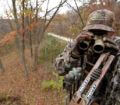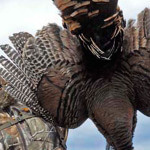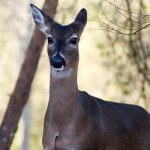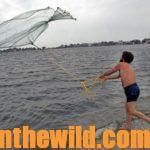Editor’s Note: If you put deer attractants along the edges of trails that deer use every day, they don’t have to find the attractants but will pass by them regularly. You’ll see more deer at your deer attractant sites next to trails, than if you just put an attractant out in the middle of the woods where there’s no deer sign at all.
 Many outdoorsmen waste thousands of hours hunting over trails deer never use during daylight hours. One of the best ways to decide whether or not a trail you’re looking at is a night trail is if it has numbers of tracks on it and goes straight in one direction. These trails are the ones deer use to get from point A to point B. The animals don’t meander along these trails and feed, walk these trails in search of does or take these paths to and from food sources during daylight hours. Like us when we’re traveling from one point to another, deer will take a woods interstate, which is the most-direct route. However, if we want to pick-up a date, get something to eat or be social with friends, we must get off the highway and so must the deer. These night trails are easy to see in open woodlots and appear to be productive places to hunt.
Many outdoorsmen waste thousands of hours hunting over trails deer never use during daylight hours. One of the best ways to decide whether or not a trail you’re looking at is a night trail is if it has numbers of tracks on it and goes straight in one direction. These trails are the ones deer use to get from point A to point B. The animals don’t meander along these trails and feed, walk these trails in search of does or take these paths to and from food sources during daylight hours. Like us when we’re traveling from one point to another, deer will take a woods interstate, which is the most-direct route. However, if we want to pick-up a date, get something to eat or be social with friends, we must get off the highway and so must the deer. These night trails are easy to see in open woodlots and appear to be productive places to hunt.
To pinpoint whether or not these paths are nighttime trails, use a trail camera. Since these night trails are easy to locate and well-defined, most hunters often will hunt here, although usually these trails may have the most-hunting pressure during daylight hours. To avoid the hunter, the deer using this trail only will come out after dark. Jamie Bulger, a longtime Georgia deer hunter, reports that, “I never bowhunt heavily-used trails but instead get off those trails and locate a secondary trail that’s downwind of the major trail. Too, I always wear a cover-up scent, usually one with pine odor, because I hunt mainly in pine forest. I’ll also hang scent cover-ups around my tree stand. Probably the least-productive trail is one in a very-open area. When you easily can distinguish a trail going through an open region, and you think, ‘Boy, deer are tearing-up this place most of the time,’ that trail probably is being used during the night, because it’s so open.”
 Also, as Mike Fine, another avid deer hunter, comments, “Manmade trails in the woods, like horse trails, hiking trails, snowmobile trails, etc., are the least productive to hunt, even though they may have numbers of deer tracks on them. Those trails probably are being used by deer only at night. Large, mature bucks won’t use heavier-traveled trails during the day that most of the immature bucks, does and fawns travel but rather will use trails that are less discernible, usually not far from major trails.”
Also, as Mike Fine, another avid deer hunter, comments, “Manmade trails in the woods, like horse trails, hiking trails, snowmobile trails, etc., are the least productive to hunt, even though they may have numbers of deer tracks on them. Those trails probably are being used by deer only at night. Large, mature bucks won’t use heavier-traveled trails during the day that most of the immature bucks, does and fawns travel but rather will use trails that are less discernible, usually not far from major trails.”
 Find the trails that intersect these well-defined trails, move-down those secondary trails, and put-out your deer attractant. Plan to hunt these trails early in the morning, and reach your stand before daylight. The bucks that have used the nighttime trails to go back and forth to food sources more than likely will be using these secondary trails to go back to their bedding areas early in the morning. Deer attractant sites on the secondary trails also can be more productive late in the afternoon, as deer start coming down the secondary trails heading toward their night trails. You’ll often be able to stop them on those secondary trails with a deer attractant and/or cause them to use those secondary trails later in the morning or earlier in the afternoon, because they’re coming to the deer attractant products before dark.
Find the trails that intersect these well-defined trails, move-down those secondary trails, and put-out your deer attractant. Plan to hunt these trails early in the morning, and reach your stand before daylight. The bucks that have used the nighttime trails to go back and forth to food sources more than likely will be using these secondary trails to go back to their bedding areas early in the morning. Deer attractant sites on the secondary trails also can be more productive late in the afternoon, as deer start coming down the secondary trails heading toward their night trails. You’ll often be able to stop them on those secondary trails with a deer attractant and/or cause them to use those secondary trails later in the morning or earlier in the afternoon, because they’re coming to the deer attractant products before dark.
To be consistently effective at taking whitetails, you must find various types of trails and learn where the deer are going and why they’re traveling to these regions, as well as when. After gathering that information, try to put a tree stand where you can arrow a buck and where you can put-out deer attractant products to increase your odds and possibly pull the buck out during daylight hours. When a big buck moves down that deer highway, at a time you’ve pre-determined he will, and stops at your attractant site, then when you sight-in on your target, you’ll understand immediately why all your research, scouting for trails and putting-out deer attractant has been worthwhile.
 To learn more information on women hunting, check out John E. Phillips’ book, “Outdoor Women’s Hall of Fame” (https://www.amazon.com/Outdoor-Womens-Hall-Fame-Premier-ebook/dp/B0771VP16V).
To learn more information on women hunting, check out John E. Phillips’ book, “Outdoor Women’s Hall of Fame” (https://www.amazon.com/Outdoor-Womens-Hall-Fame-Premier-ebook/dp/B0771VP16V).
 To receive your free book on “How to Make Venison Jerky,” go to https://www.emailmeform.com/builder/form/Ece3UZVcOo52cKPJcL.
To receive your free book on “How to Make Venison Jerky,” go to https://www.emailmeform.com/builder/form/Ece3UZVcOo52cKPJcL.










